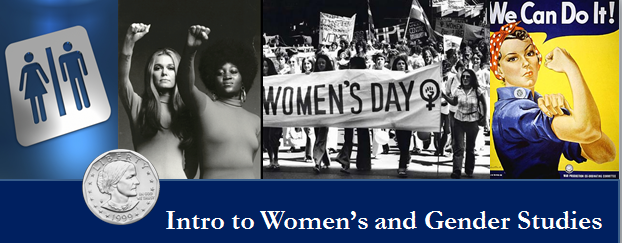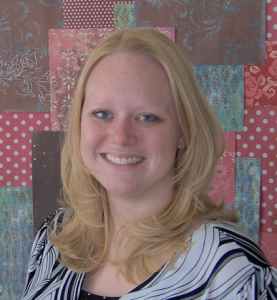 Taught face-to-face and online, individually and as a team.
Taught face-to-face and online, individually and as a team.
Course Description and Philosophy:
So why a course devoted to the study of women and gender? Historically, women’s lives and experiences were excluded from traditional academic areas of study and rarely discussed in courses in subjects such as history, literature, and law. In the 1970s, Women’s Studies departments were created on university and college campuses across the United States, and their mission has been to create a place for the interdisciplinary study of women, gender, and associated modes of difference in society like sexuality, race/ethnicity, socio-economic status, and (dis)ability. This course will serve as an introduction to the diverse and dynamic field of Women’s and Gender Studies (WGS). The historical portion of the course will focus on the United States, but we will also discuss international women’s movements and issues in a more contemporary context. We will read and discus texts (written and filmed) in feminist theory, examine primary historical documents, and become familiar with a wide array of approaches to WGS, both historical and contemporary.
A few of the questions we might pose and investigate this semester include the following:
- What is Women’s and Gender Studies? Why is WGS vital in the twenty-first century?
- How do women’s texts from earlier decades still speak to us today? What can we learn from them?
- How have gender roles, sexuality, physical ability, class, and race affected women at various historical moments, including our own?
- What is feminism? What is the relationship between feminism and WGS?
- How do gender roles shape our lives and communities? Is our understanding of gender and gender identity changing?
Course Objectives:
- To become familiar with the foundational texts, ideas, historical figures, theoretical debates, and general trajectory of women’s rights movements and feminism(s) in the United States from the 19th century to the present.
- To synthesize material from diverse disciplines and experiences and apply a “gender lens” to reflect critically on women and gender.
- To analyze intersections of gender with other social identities such as race, religion, social class, ethnicity, nationality, age, physical ability, and sexual orientation.
- To display awareness of global issues concerning women, gender, sexuality, and transnational feminisms.
- To engage in and practice critical reading, thinking, and writing in response to course texts and materials through written work and in-class discussions.
Texts:
- Feminist Frontiers (8th edition), Eds. Verta Taylor, Nancy Whittier, Leila J. Rupp; ISBN: 978-0073404301
- Articles, web pages, or videos linked through or posted on Blackboard
Bibliography of Articles:
- Baumgardner, Jennifer & Amy Richards. “A Day without Feminism.” Manifesta: Young Women, Feminism, and the Future. New York: Farrar, Straus, and Giroux, 2000. 3-9. Print.
- Beauvior, Simone de. Introduction. The Second Sex. Trans. H. M. Parshley. 1952. New York: Vintage, 1989. Print.
- Friedan, Betty. “The Problem that Has No Name.” The Feminine Mystique. 1963. New York: Norton, 2001. 15-32. Print.
- Lorde, Audre. “Age, Race, Class, and Sex: Women Redefining Difference.” 1980. Sister Outsider: Essays and Speeches. Berkeley, CA: Crossing Press, 1984. 114-123. Print.
- Lorde, Audre. “The Master’s Tools Will Never Dismantle the Master’s House.” Sister Outsider: Essays and Speeches. Berkeley, CA: Crossing Press, 1984. 110-113. Print.
- Matsumoto, Valerie. “Japanese American Women During World War II.” Frontiers: A Journal of Women Studies VIII(1), 1984. Print.
- Milkman, Ruth. “Gender at Work: The Sexual Division of Labor during World War II.” Women’s America: Refocusing the Past. Eds. Linda K. Kerber & Jane Sherronn De Hart. 6th ed. New York: Oxford University Press, 2004. 466-477. Print.
- Reagan, Leslie J. “When Abortion Was a Crime: Reproduction and the Economy in the Great Depression.” Women’s America: Refocusing the Past. Eds. Linda K. Kerber & Jane Sherronn De Hart. 6th ed. New York: Oxford University Press, 2004. 423-428. Print.
- Rich, Adrienne. “Compulsory Heterosexuality and Lesbian Existence.” Feminist Frameworks: Alternative Theoretical Accounts of the Relations Between Women and Men. Eds. Alison Jaggar & Paula Rothenberg. 2nd ed. New York: McGraw-Hill, 1993. 489-491. Print.
- Rowe-Finkbeiner, Kristin. “Signs of the Times: Defining the Third Wave.” The F-Word: Feminism in Jeopardy: Women, Politics, and the Future. Emeryville, CA: Seal Press, 2004. 85-105. Print.
- Sanger, Margaret. “X. Contraceptives or Abortion?” Woman and the New Race. 1920. Web. 18 Oct 2006. http://www.bartleby.com/1013/10.html.
- Sanger, Margaret. Family Limitation. 1914. 6th ed. 1917. Print.
- Stanton, Elizabeth Cady. “The Declaration of Sentiments.” Modern History Sourcebook. 1848. Web. June 22, 2007. http://www.fordham.edu/halsall/mod/Senecafalls.html.
- Valenti, Jessica. “You’re a Feminist. Deal.” We Don’t Need Another Wave: Dispatches from the Next Generation of Feminists. Ed. Melody Berger. Emeryville, CA: Seal Press, 2006. 23-27. Print.


